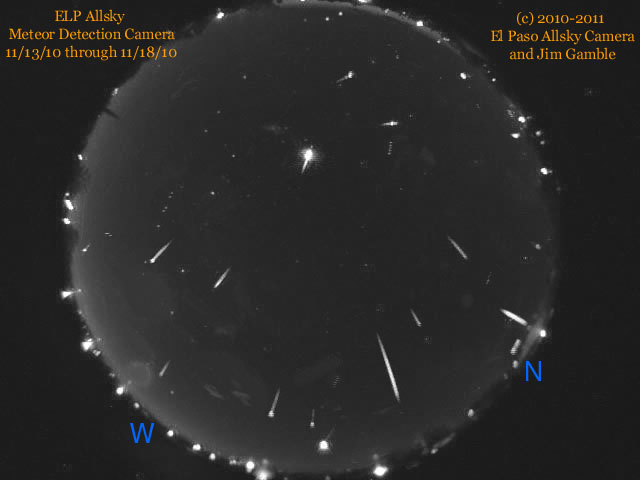Moderate Leonid Meteor Shower Doesn't Disappoint Skywatchers

The Leonidmeteor shower of 2010 may not have dazzled, but it still caught the eyes of die-hardskywatchers who awoke before dawn today to catch the moderate shooting starshow at its peak.
SkywatcherJim Gamble of El Paso, Texas has been observing the Leonids meteor displaythroughout the month. He used an all-sky camera to record the brightstreaks created by the meteors and created a composite snapshot of this year'sLeonids shower between Nov. 13 and today (Nov. 18). [Gamble's composite photo of the Leonid meteor shower]
"Notthe best show ... but respectable," Gamble told SPACE.com today.
The Leonidmeteor shower returns every year in mid-November. It occurs when the Earthpasses through a stream of dust leftover from the Comet Tempel-Tuttle. Thematerial hits the atmosphere and then flares up as "shootingstars."
When theEarth passes through the denser parts of the stream, the meteor count can soarto hundreds or thousands in an hour. [Gallery:Spectacular Leonid Meteor Shower Photos]
This year,however, the Earth is passing through a less dense part of the comet debrisstream, astronomers have said.
The Leonidmeteor shower of 2010 promised between 15 and 20 meteors an hour forskywatchers graced with clear skies, according to predictions from meteorexperts. The best time to observe the show was in the hours before sunrise onWednesday (Nov. 17) and today.
Breaking space news, the latest updates on rocket launches, skywatching events and more!
Internationalmeteor counts have officially pegged this year's Leonids at less than 25meteors an hour, according to the website Spaceweather.com, which monitorsspace weather and skywatching events.
Still, thepromise of only a modest meteor show did not dissuade avid meteor gazers.
InJerusalem, skywatcher Yaron Eini made it a group event, but was sureeveryone bundled up warm while observing.
"We hada nice weather for this season," Eini toldSpaceweather.com. "It was comfortable for us to lay down in oursleeping bags and enjoy the modest Leonids meteor shower."
The nextmajor meteor show for skywatchers will be the Geminid meteor shower, which willpeak on Dec.13 and 14.
- Top 10 Leonid Meteor Shower Facts
- Images - The Best of Leonid Meteor Shower, 2, 3, 4, 5
- The Leonid Meteor Shower Revealed: Shooting Star Show's Brilliant History

Tariq is the award-winning Editor-in-Chief of Space.com and joined the team in 2001. He covers human spaceflight, as well as skywatching and entertainment. He became Space.com's Editor-in-Chief in 2019. Before joining Space.com, Tariq was a staff reporter for The Los Angeles Times covering education and city beats in La Habra, Fullerton and Huntington Beach. He's a recipient of the 2022 Harry Kolcum Award for excellence in space reporting and the 2025 Space Pioneer Award from the National Space Society. He is an Eagle Scout and Space Camp alum with journalism degrees from the USC and NYU. You can find Tariq at Space.com and as the co-host to the This Week In Space podcast on the TWiT network. To see his latest project, you can follow Tariq on Twitter @tariqjmalik.
